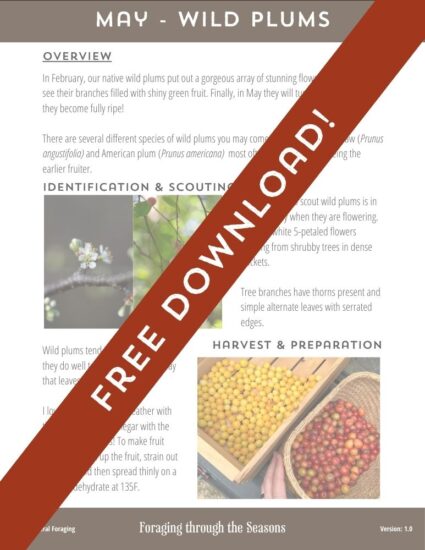American lotus Nelumbo lutea may be the greatest staple wild food in all of North America. Yet, somehow more Americans know about its Asian cousin than their own native plant!
In this article I want to show you everything you need to know to find, forage, and eat American lotus.
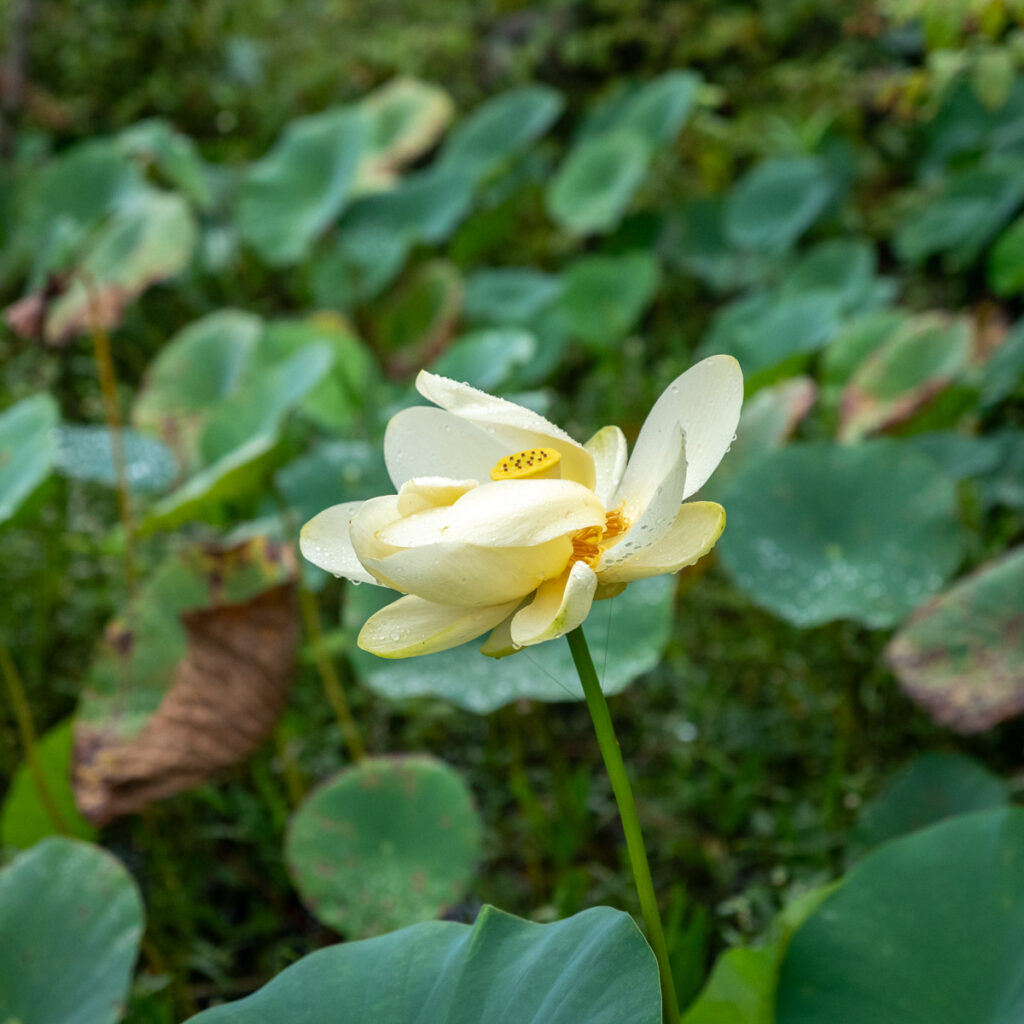
Identification
- Growth Habit: Aquatic plant with large, circular, floating or emergent leaves, often reaching 18-24 inches in diameter, forms extensive colonies
- Leaves lacking a notch, having a distinctive central depression, and are bright green, rising above the water surface on stout stalks
- Flowers: Large, showy, and pale yellow in color, up to 10 inches across, with numerous petals and a central, cone-like structure, blooming mid-to-late summer
- Seeds: Distinctive, conical, seed-head structure with numerous seeds in pits
- Habitat: Grows in shallow, muddy waters of ponds, lakes, and slow-moving rivers
How to find American Lotus
If you’re looking for them in the right areas when they’re flowering, American lotus is a very easy plant to spot! Their huge circular leaves and cream-yellow flowers are a big indicator.
Timing and seasonality
American lotus leaves emerge from long shoots growing through the water from the tubers in the mucky bottom.
When the weather gets warmer at the beginning of summer, they send their flowers up and put on an amazing display! Lotus populations are “indeterminate” so they continue to flower until they go dormant later in late autumn.
Once you see the flowers, mark your calendar for about six weeks in the future. Because they continuously flower at that time, you’ll be able to find both immature and fully mature seeds!
The tubers can be found in colder months once the day length begins to shorten.
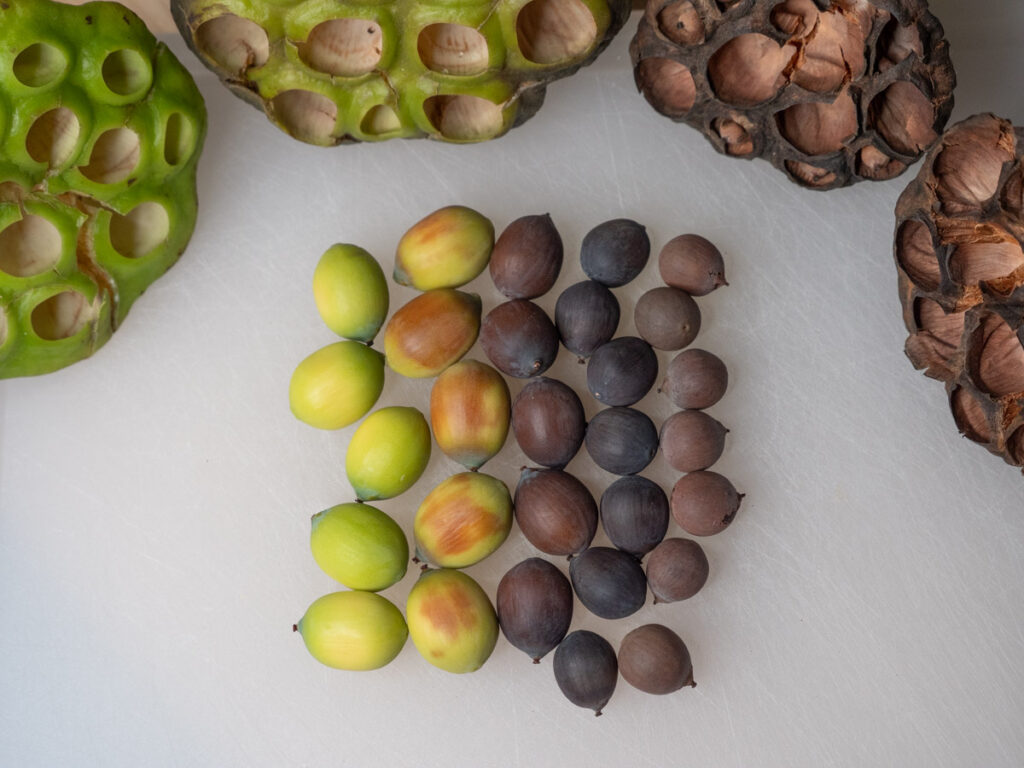
Habitat
American lotus is an aquatic plant and it prefers shallow, slow-moving waters. Lakes and ponds make great locations to look for them. I typically find them in areas that have more open water mixed in, not in dense swamps.

Range
American lotus is native to central and eastern North America. They can be found as far north as Minnesota and Wisconsin, as far south as Texas and Florida, and as far west as Kansas and Oklahoma.

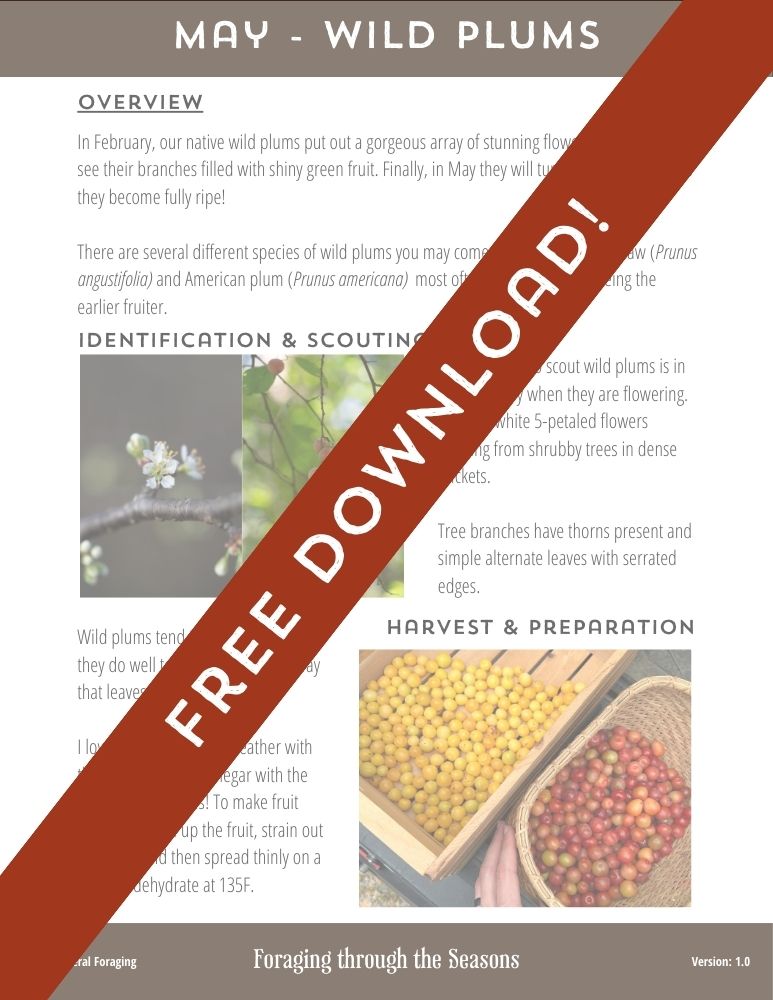
Get my foraging guide!
Learn an amazing wild food for each month of the year with my guide, Foraging through the Seasons!
Enter your email below to have this FREE guide sent straight to your inbox!
Gathering
Seeds
Timing and location are two important aspects of gathering lotus seeds.
It’s best to go early in the morning or late in the afternoon to avoid getting too much sun! It can be very hot during lotus nut harvesting season.
You can find good locations for seeds by observing populations that flower vigorously. From the point that lotus flowers, it will usually take around 28 days for those seeds to reach complete maturity (when they’re dry) and 14 days to reach their full size.
If you find a location with many seed heads, but they aren’t doing well; either they don’t have many seeds per head, a lot of them aren’t viable, or a lot of them have bug holes in them (on the outside of the seed heads or the individual seeds), it’s best to try another spot.
Sometimes I’ve found that another spot just a hundred yards away from one poor location produced dramatically better results. So once you have found a good location how are we actually going to get them.
By far, the most efficient method works with two people in a canoe. One person is the paddler or “pole”-er and the other is the gatherer. You don’t really need any cutting equipment, but an extendable pole with a hook can definitely help reduce the amount of maneuvering that you need to do.
From there, bend the seed head at the base and then pull if it doesn’t snap. Gathering mature seed heads is definitely easier. Throw them right in the canoe! You can take a gathering container with you, especially if you are getting mature seed heads, as the individual seeds will easily pop out at that stage.
From there, you can sort out the two different stages, and you’re ready for processing!
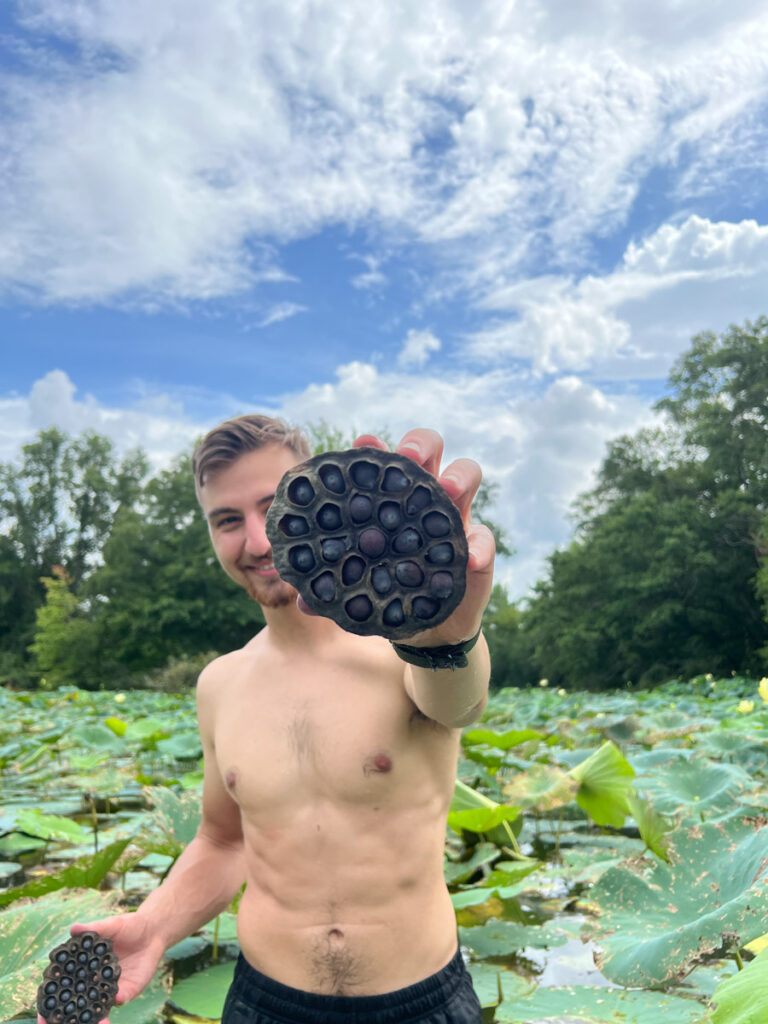
Tubers
Ideally, find a location where the water level falls and lotus grows by the shore to leave behind a mucky area from which to gather them.
Digging wild lotus tubers can be quite difficult and requires a fair bit of skill. You can either find an area with an ample amount of them and start digging around or follow along the rhizomes until they terminate in an enlarged tuber.
Take care not to break the tubers when you are digging them!
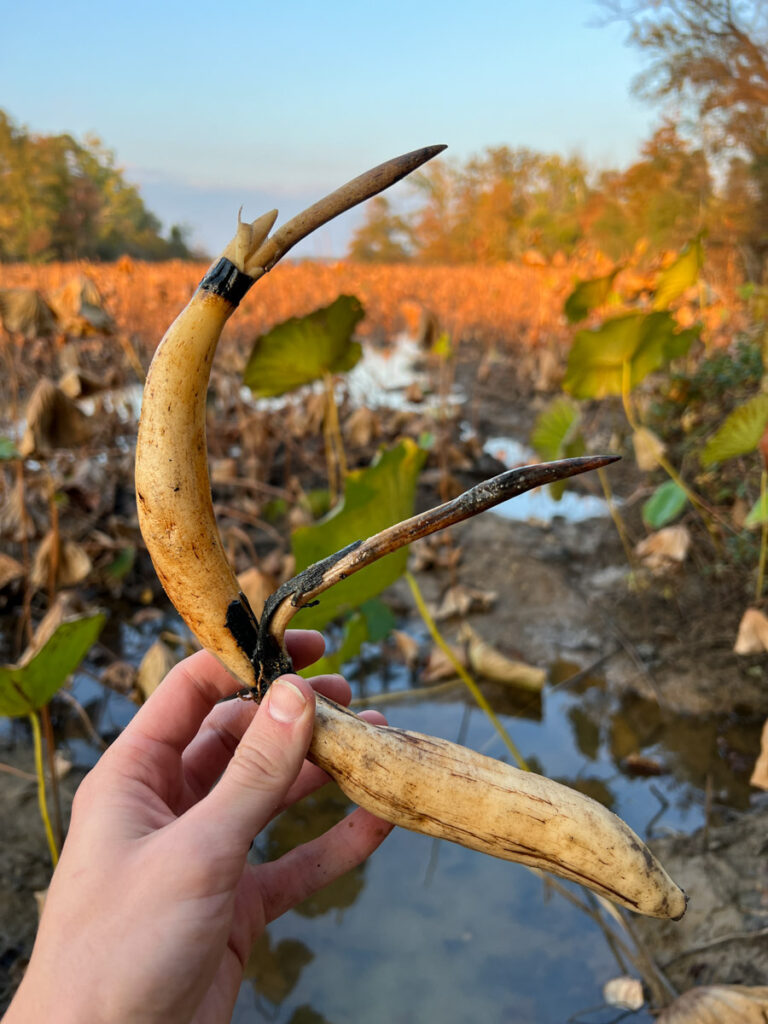
Edibility
Immature seeds
The young, immature seeds of lotus can be eaten in addition to the mature ones. There are two stages of immature nuts that you can use.
If they are just right, young enough that they have started to enlarge, but with a seed coating that is easily pierced, these are the best for eating raw. Simply remove the nut from the outer shell, try to remove the thin testa coating, and pop them in your mouth!
You don’t need to remove the embryo on the inside as it will be so young that it won’t contribute any bitterness.

Mature (dried) seeds
The mature seeds are one of the most versatile wild foods on the entire planet.
They can be processed into a flour that produces fluffy baked goods without additives. I don’t know of any gluten-free flour, wild or not, that performs anywhere close to American lotus!
Our favorite recipe to make with lotus flour is Lotus bread! (click the link for the recipe article for that one)
Another great and straightforward option is to make lotus porridge. All you need to do is roughly blend the mature nuts, add water, and put on the heat for about two minutes.
You’ll be rewarded with a delicious breakfast that puts oatmeal to shame!
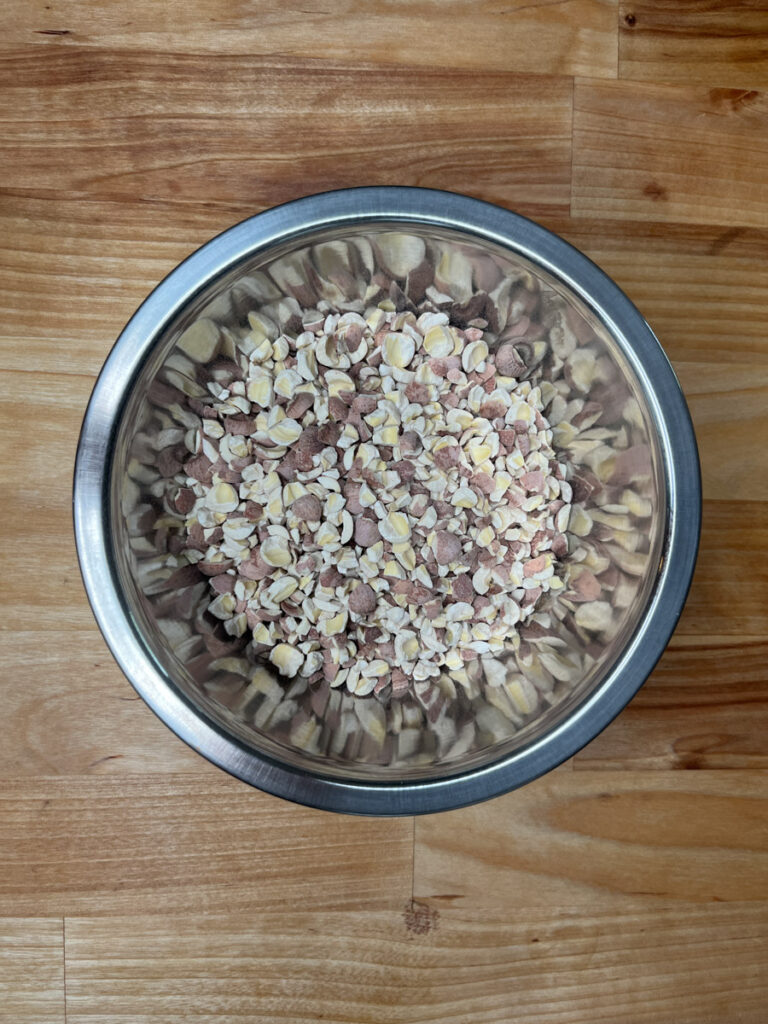
Tubers
The hole-y tubers of lotus are one of the more iconic food products from this plant. They can be used much like you would other common starchy-tubers like potato, but they have a bit more of a “crunch” to them!
We mainly use them sauteed or in soups!
Benefits and nutrition
Dried lotus seeds contain 332 calories per 100 grams and raw seeds contain 89 calories per 100 grams.
In addition, the seeds contain a meaningful amount of vitamins and minerals like:
- calcium
- iron
- magnesium
- phosphorus
- potassium
- zinc
- copper
- manganese
- folate
Processing seeds
Throw everything into a gunny sack, then just step on it to crush them all.
Dump the contents into a container and remove the large seed heads, plucking out any seeds that remain stuck in the seed head.
You can then do a quick winnow to easily remove smaller broken-up pieces of the seed heads.
Next, fill a bucket with water and add all the seeds in. This will simultaneously clean the exterior and sort any bad nuts that are floating. Remove the floaters.
Pour all the contents through a filter and then lay out the seeds to dry. You can store them in this state for literally hundreds of years.
Next, we have to crack the nuts. You can do this with a hammer, but if you want to process hundreds of lotus nuts, you’ll want to invest in a Davebilt nutcracker.
After cracking all the nuts, we go through a series of winnowing and sorting to remove them from their shells and the bitter green embryo inside.
Lookalikes
American lotus vs Water Lily (Nymphaea)
American lotus and lotuses are often mistaken for “lily,” which are actually part of a different plant family from lotus. Here are simple distinguishing characteristics to tell them apart.
| Feature | Nelumbo lutea (American Lotus) | Nymphaea spp. (Water Lilies) |
|---|---|---|
| Leaf Shape | Circular with a smooth, unbroken edge, larger often greater than 2ft in diamater | Circular but with a distinct notch or cleft at the base, smaller than 2ft in diameter |
| Leaf Position | Held above or floating on water | Always floating on the water surface |
| Flower Shape | Large, cup-shaped with a central seed pod | Star-like with numerous petals and no central pod |
| Flower Position | Rises well above the water on a tall stalk | Floats on or just above the water surface |
Remarks
One of the most common points of confusion that people comment about in my lotus videos is about a product called “puffed lotus” or “Makhana.” This product actually doesn’t come from lotus (Nelumbo) at all, but rather from a relative of Nymphea – Water Lily called Euryale ferox – Fox Nut.

Closing thoughts
I think is an untapped resource in America’s landscape that deserves our attention and energy!
This plant produces food that is local, healthy, and delicious!
I hope that article provides you with the information you need to start building a relationship with America lotus through foraging it!



